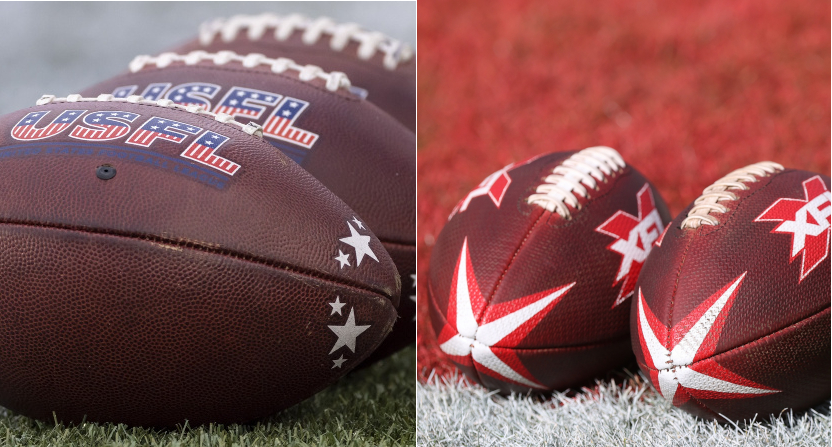From early September 2022 through early July 2023, sports fans could watch professional football continuously without interruption, meaning a week didn’t go by without at least one pro game. That’s because the third iteration of the XFL launched its first season the week after the Super Bowl, and the second season of the USFL started in mid-April 2023 (toward the end of the XFL campaign) and stretched into July.
That’s a lot of football, and despite what the Hank Williams Jr. song asks, fans weren’t quite ready for it. That’s why news last week of merger talks between the two entities is such good news for those who want spring football and would like to see it survive. (UPDATE: The plan for merger was officially announced on Thursday.)
“A merger is the best chance for sure for the two leagues to do well, for spring football to survive,” said Randy Vataha, a former New England Patriot who owned an original USFL team in the 1980s and is now a sports investment banker.
The XFL, largely aired on ESPN, and the USFL, mainly broadcast by its owner Fox Sports, ended with very similar average viewerships in 2023. The USFL clocked in at an average viewership of 604,000, and the XFL 622,000. The XFL’s title game earned 1.4 million viewers, 200,000 more than the USFL’s.
Those are not terrible figures. As Vataha points out, they beat the average for regular season NHL games. In the 2022-23 regular season, NHL games on ABC and ESPN averaged 583,000 viewers, and 364,000 on Turner. But they don’t exactly scream relevance.
So will the merger mean higher TV ratings? Arguably, the leagues could pluck the top markets from each league, put more marketing muscle behind them, and thrive. But football is an expensive proposition, with far larger rosters than other sports, high medical insurance rates, and there is a dearth of top QBs to energize fans.. The history of spring football is populated with the carcasses of endeavors proudly touted and quickly consumed and spit out.
The XFL lasted one season in 2001 under WWE and NBC ownership, and half a season in 2020 under WWE then boss Vince McMahon (Covid ended this league, it probably had a chance otherwise). The Alliance for American Football filed for bankruptcy eight weeks into its inaugural 2019 season. There were a host of other leagues, such as NFL Europe, and of course the original USFL which shuttered following three seasons in 1986 after winning an antitrust case against the NFL but was only awarded $3.
These leagues face hurdles for many reasons. In terms of acting as a minor league of sorts, that function is already played by college football. Funding a startup football league is expensive; McMahon spent hundreds of millions of dollars on his short lived XFL 2.0. The USFL has tried to limit costs with hub cities, while the XFL teams are all headquartered in one location, traveling to host cities for games.
“How do you build a fanbase?” Vataha asked about this strategy. TV viewership may be mediocre because there are few real fan bases. But to run a traditional league with teams based in their home cities is pricey.
There are a lot of unanswered questions about a merger, again if it happens. What name would the new league keep? (The USFL filed recently for a trademark for the National Spring Football League.) Would the hub system be abandoned? How many teams will be in the league as each currently field 8 teams? Who would run the league? Fox owns the USFL, while the XFL is a partnership between Dwayne Johnson, Dany Garcia and RedBird Capital Partners.
To get viewership up to over a million per game, reducing the steady supply of minor league football is step one, so a merger checks that box. While the answer is almost certainly no to the question of is there enough high level talent to populate two leagues, it’s still unclear if there is enough for one. It’s not just quarterbacks, but talented offensive and defensive lineman these leagues historically have struggled to find.
There are of course success stories of players from these leagues making the back end of an NFL roster. But if they represent the best of the USFL and XFL, but the bottom of an NFL team’s depth chart, will fans truly gravitate to spring football?
Vataha for one does believe in spring football despite the time-honored tradition of failure. In fact, it was quite the milestone the USFL made it to a year two.
“I definitely believe that there is a market,” he said. “But it’s an expensive sport. That’s the one thing everybody thinks they can control. And they do all their financial projections. And you’re right, and all that ticket sales, and attendance figures and all that, but it’s always much more expensive than people think. And so, you’ve got to get up to a pretty fair level of revenue to make football work.”
A merged XFL and USFL would have a few advantages however. Fox and ESPN are looking for content and half a million to a million viewers in certain time slots is passable. As legalized gambling continues to spread, demand will grow for the league’s official data. And the NFL has appeared more willing to work with these leagues, though a financial play doesn’t seem to be in the offing.
The right time for a newly merged league’s season to start is also a riddle. The XFL chose the week after the Super Bowl under the premise fans were focused on football. The USFL chose mid-April because with the season ending in early July, players could easily transition to NFL camps. Somewhere in between is probably the answer.
One thing seems clear, there will be spring football in 2024, just how much we don’t know yet.
